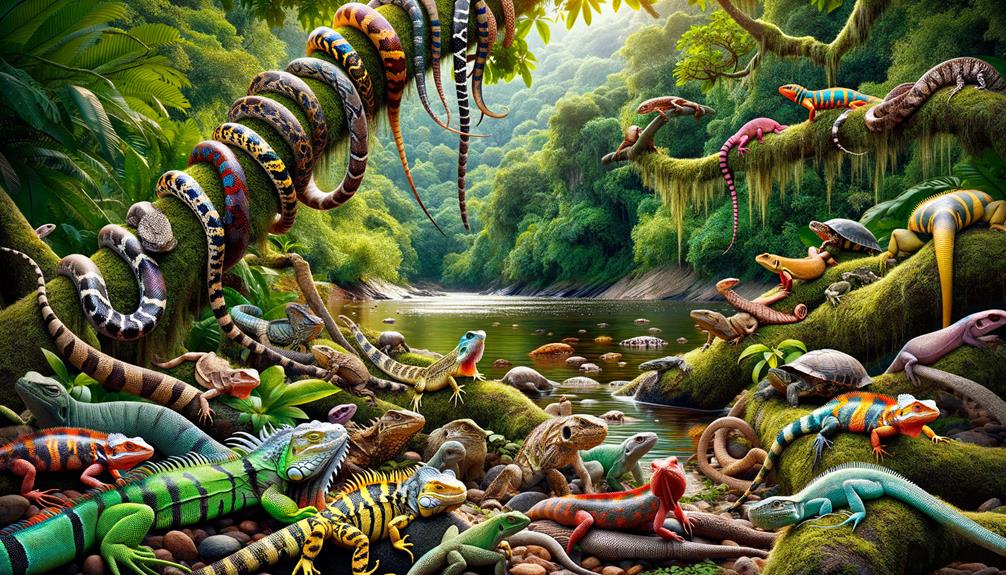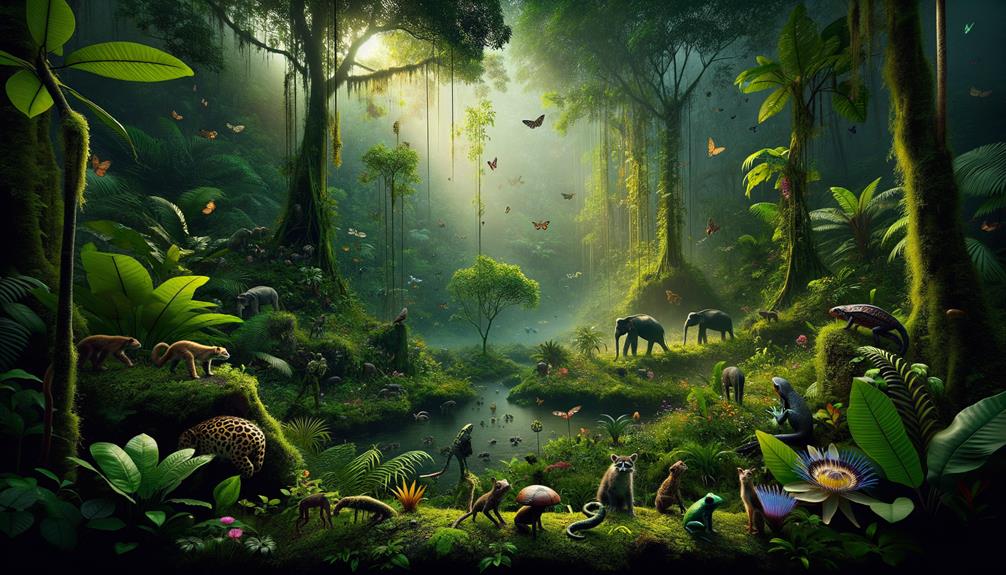Peru's rainforests are home to a stunning array of reptiles, boasting incredible diversity across various habitats. Imagine the Amazon's massive green anaconda, one of the largest snakes, slithering through dense vegetation or caimans patrolling waterways. High-altitude cloud forests harbor unique lizard species, while arid regions are home to the Machu Picchu lizard. These reptiles play a vital role in their ecosystems, controlling rodent populations and dispersing seeds. Conservation efforts are crucial, with organizations establishing reserves and promoting awareness about the importance of preserving these species. Scientific research continues to uncover new species, deepening our understanding of ecological interactions and conservation needs. Fascinating discoveries and conservation stories await, revealing Peru's true reptilian wonders.
Key Takeaways
Peru's Amazon rainforest is a haven for iconic reptiles, including the green anaconda, caiman, and yellow-spotted side-neck turtle. The diverse habitats, ranging from dense jungles to swamps, support a rich variety of reptilian life. Reptiles play a vital role in regulating populations and maintaining balance within their ecosystems. Conservation efforts focus on preserving habitats, promoting sustainable practices, and raising public awareness to protect reptilian biodiversity. In Manu National Park, guided tours offer visitors a unique opportunity to observe these vibrant rainforest reptiles in their natural habitats.
Diverse Reptilian Habitats
Peru's stunning array of reptilian habitats showcases the country's ecological diversity, ranging from the lush Amazon rainforests to the cool, misty cloud forests of the Andes. As I venture into the Amazon rainforest, I marvel at the complex network of rivers, swamps, and dense vegetation that create ideal environments for various reptile species. The green anaconda, an awe-inspiring creature, silently glides through these murky waters, epitomizing the raw, untamed beauty of the Amazon.
In contrast, the cloud forests of the Andes offer a distinct kind of wonder. Here, the cool, humid conditions nurture a variety of lizard species, each adapted to thrive in this unique environment. The diversity of reptilian life in these regions highlights Peru's remarkable ecological complexity.
Moving towards the arid coastal regions, I encounter the Machu Picchu lizard, a species that has evolved to survive in drier climates. This adaptability across various habitats underscores the fascinating evolutionary paths these reptiles have taken. Peru's varied landscapes, from dense jungles to high-altitude forests, provide a rich tapestry of habitats that support an incredible array of reptilian life.
Iconic Reptile Species
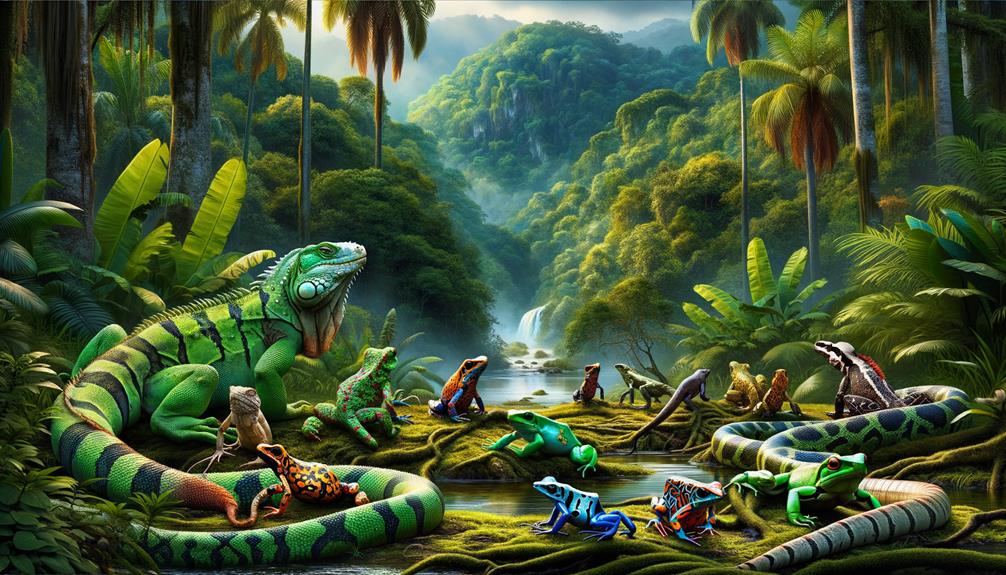
Among the incredible array of reptilian life in the Amazon rainforest, the green anaconda stands out as a true giant, embodying the power and mystery of this lush ecosystem. This species, one of the largest snakes in the world, can grow over 29 feet long and weigh more than 550 pounds. As I venture deeper into the Amazon, the sheer size and strength of the green anaconda never cease to amaze me. It silently navigates the murky waters, a formidable predator waiting for its next meal.
Another iconic species in the Amazon is the caiman, a close relative of alligators. Dominating the waterways, these reptiles play a vital role, both as hunters and as prey. The yellow-spotted side-neck turtle, one of the largest river turtles in South America, is also a fascinating creature. Growing up to 17 inches long and weighing up to 17 pounds, it's a symbol of the Amazon's rich biodiversity.
Lastly, the jaguar, though not a reptile, is worth mentioning for its interactions with these species. As an excellent swimmer and climber, it preys on green anacondas and caimans, adding another layer of intrigue to this vibrant ecosystem.
Ecological Roles
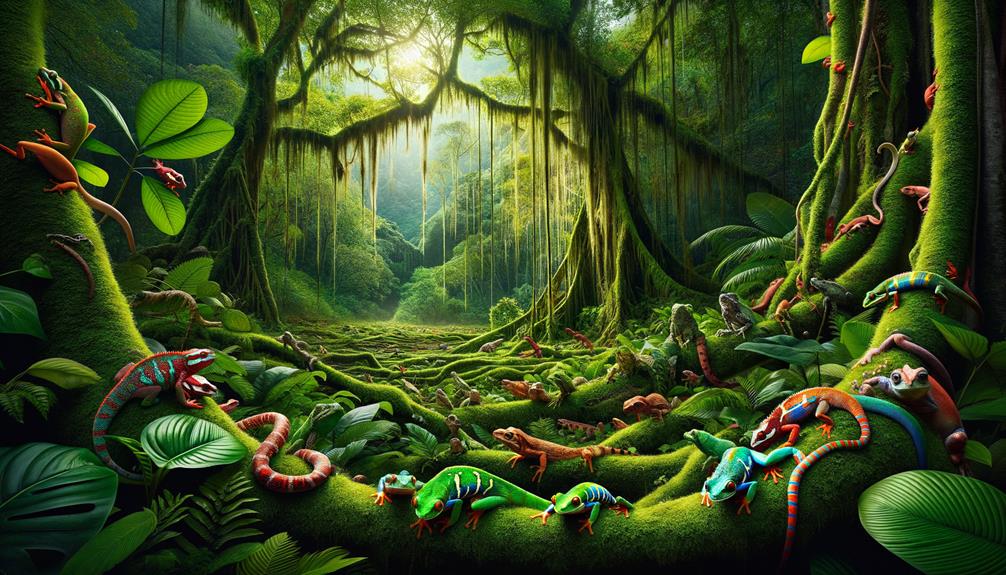
As I venture into the realm of rainforest reptiles, I'm struck by their profound impact on the delicate balance of their ecosystems. These vibrant creatures play a vital role in regulating predator-prey dynamics, dispersing seeds, and controlling pest populations. By understanding their multifaceted contributions, we gain a deeper appreciation for the intricate web of life within these biodiverse habitats.
Predators and Prey Dynamics
In the Peruvian rainforest, caimans sit atop the food chain, their dominance shaping the ecosystem as they prey on fish, birds, and small mammals. The black caiman, the largest of its kind, exerts significant influence over its habitat, maintaining the delicate balance of species. Meanwhile, green anacondas lie in wait, their stealth and power making them key components of the rainforest's predatory hierarchy.
On the forest floor, the tiny poison dart frog employs a unique survival strategy. Its brightly colored skin warns potential predators of the potent toxins it secretes, effectively deterring attackers and securing its place in the ecosystem. In contrast, venomous snakes like the bushmaster rely on their hemotoxins to immobilize prey, showcasing the diverse methods of predation within this lush environment.
Camouflaged lizards, such as the Machu Picchu lizard, navigate this complex web of predators and prey with agility and stealth, capturing insects while avoiding threats. Each creature, whether predator or prey, plays a distinct role in the dynamic balance of the Peruvian rainforest, highlighting the intricate relationships within this vibrant ecosystem.
Seed Dispersal Agents
In the Peruvian rainforest, reptiles like boa constrictors and green iguanas play a vital role in maintaining the ecosystem's balance by dispersing seeds. These remarkable creatures consume fruits and then excrete the seeds in new locations, facilitating the spread of plant species across the Amazon basin. This process is crucial for the continued regeneration and biodiversity of the forest, especially in the face of habitat destruction.
Arboreal lizards and snakes navigate through the tree canopy, dispersing seeds from the fruits they eat. This high-altitude movement ensures that seeds are distributed over a wide area, promoting varied plant regeneration. In the waterways, caiman species consume aquatic fruits and deposit seeds along riverbanks, supporting the growth of riverine plant species. The yellow-spotted side-neck turtle also aids in seed dispersal by eating fallen fruits and excreting the seeds in new water bodies.
The diverse reptile assemblage in the Peruvian Amazon acts as nature's guardians, safeguarding the ecological balance. By dispersing seeds, they help counteract the adverse effects of habitat destruction, ensuring the forest's continued vibrancy and diversity.
Pest Population Control
Beyond their role in seed dispersal, reptiles in the Peruvian Amazon play a vital role in maintaining ecological balance by preying on rodents, insects, and other potential pests. In the vast national parks, the largest predators like the boa constrictor and green anaconda regulate rodent and small mammal populations, preventing them from overwhelming their habitats and disrupting the ecosystem's delicate balance.
Lizards are also crucial in pest control, consuming vast numbers of insects and acting as natural barriers against agricultural pests that could ravage crops. Their presence highlights the intricate web of interdependence within these rainforests.
Waterways are home to turtles and caimans that manage fish, frog, and other aquatic organism populations, preventing overpopulation and ensuring the aquatic ecosystem remains vibrant and balanced. As natural biological control agents, they maintain harmony in one of the world's most biodiverse regions. The presence of these varied reptile species signifies a healthy, thriving ecosystem, essential to the Peruvian Amazon's grandeur.
Conservation Efforts
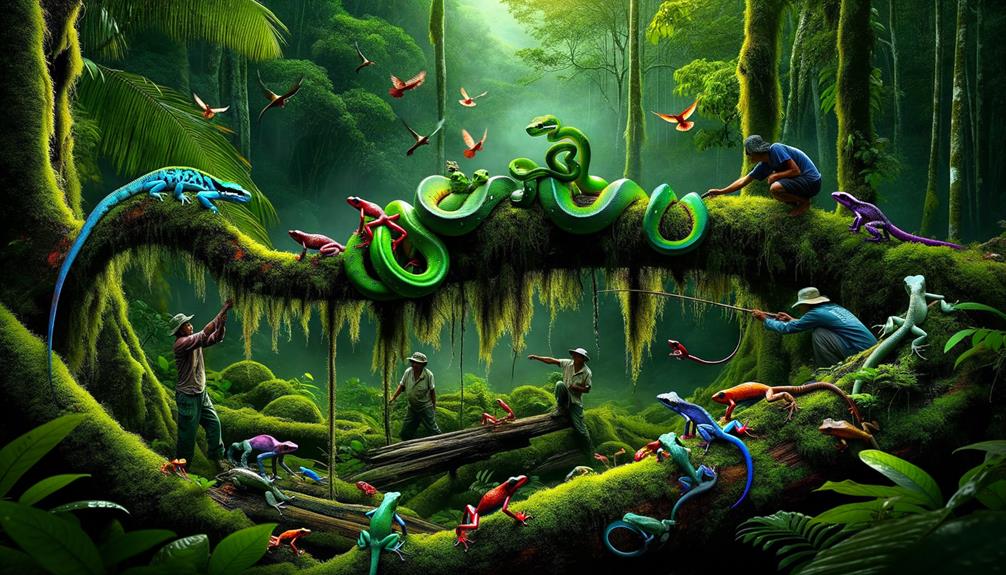
Peru's conservation organizations are going all out to safeguard its rich tapestry of amphibians and reptiles by setting up nature reserves and promoting sustainable practices. These efforts are crucial to combat the adverse effects of climate change and ensure the survival of these unique species. By creating protected areas, we're not only shielding habitats from destruction but also providing a sanctuary where scientists can gain a deeper understanding of these ecosystems.
Public awareness campaigns play a vital role in these endeavors. They highlight the importance of preserving Peru's herpetofauna, emphasizing their role in maintaining ecological balance. By engaging with local communities and fostering a culture of conservation, we can promote sustainable practices that benefit both wildlife and humans.
Monitoring programs are vital for identifying threats such as habitat destruction and pollution. Through rigorous scientific research, we can implement targeted conservation measures. Preserving the habitats of these diverse species is necessary, not just for their survival but for the overall ecological health of Peru. These efforts demonstrate our commitment to protecting the vibrant, irreplaceable life forms that thrive in Peru's rainforests.
Herpetological Research
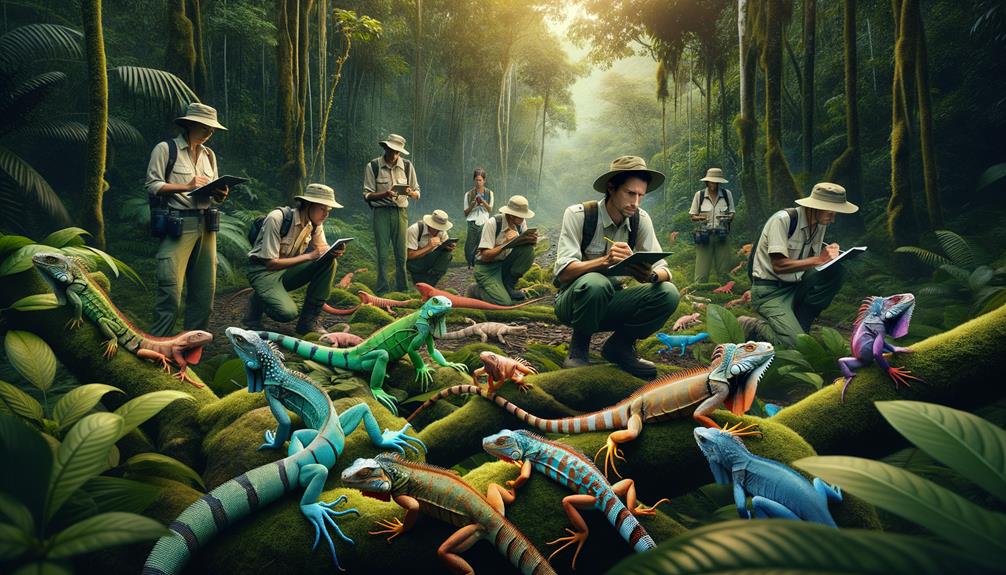
Peruvian herpetologists delve deep into the Amazon rainforest, uncovering the secrets of the region's fascinating reptiles and amphibians. Their research is crucial for understanding biodiversity, ecology, and developing effective conservation strategies. The discovery of new species is a regular occurrence, with each one providing a vital piece of the ecological puzzle. By monitoring population trends, researchers can develop targeted conservation strategies to protect these unique habitats.
The Amazon rainforest and Andean cloud forests are critical areas of focus, as they harbor a significant portion of Peru's herpetological diversity. Herpetologists work closely with conservation organizations and local communities to safeguard these magnificent creatures and their habitats.
| Research Focus | Description |
|---|---|
| Biodiversity | Identifying new species in the Peruvian Amazon. |
| Ecology | Understanding the roles reptiles play in their ecosystems. |
| Conservation Strategies | Developing methods to protect habitats. |
| Medical Applications | Exploring potential health benefits. |
Through collaboration, researchers, conservation organizations, and local communities work together to protect these incredible animals and the ecosystems they inhabit. This cooperative effort not only preserves the natural world but also deepens our understanding of the intricate relationships within ecosystems.
Visitor Experiences
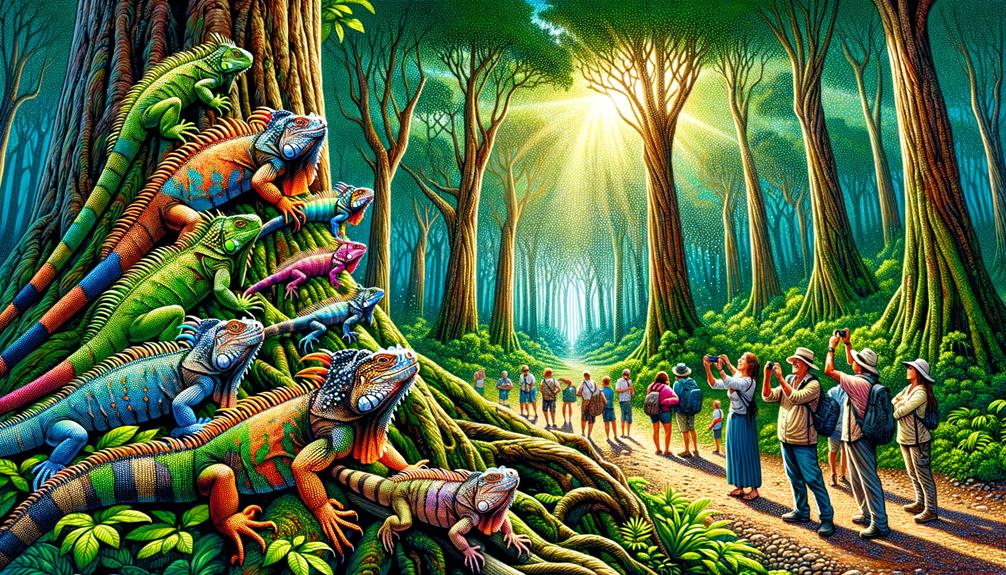
Visitors to Manu National Park can embark on life-changing journeys, immersing themselves in the vibrant world of rainforest reptiles while supporting vital conservation efforts. Through experiences like the Manu Rainforest Tour and Manu Reserved Zone Tour, I had the opportunity to observe a diverse array of species, including caimans, snakes, and lizards, each showcasing their fascinating adaptations.
The bright colors of these reptiles are breathtaking, offering a vivid glimpse into the unique adaptations that enable them to thrive in the dense Amazon Basin Rainforest. I was struck by the way some reptiles used camouflage to blend seamlessly with their surroundings, while others had specialized toe pads for agile movement through the forest canopy.
Responsible tourism in Manu National Park doesn't just offer an educational adventure; it actively supports conservation initiatives. The funds generated and awareness raised through these tours significantly contribute to the research and protection of the park's fragile ecosystems and endangered reptilian species. By joining guided tours and educational programs, I gained a deeper understanding of these incredible creatures, the threats they face, and the vital importance of ongoing conservation efforts to safeguard them for future generations.
Frequently Asked Questions
What Is an Animal That Inhabits Perus Rainforest?
In Peru's lush rainforest, the emerald tree boa is a stunning sight. I've always been drawn to its vibrant green scales, which allow it to blend seamlessly into its surroundings, embodying the perfect harmony with nature.
What Are the Reptiles in the Rainforest Habitat?
When considering reptiles in the rainforest habitat, I find caimans, lizards, snakes, and turtles fascinating creatures that bring unique characteristics to the ecosystem. From the agile cloud forest lizards to the diverse snake population, each species plays a vital role in maintaining the ecosystem's delicate balance.
What Reptile Is an Excellent Swimmer in the Amazon Rainforest?
In the Amazon rainforest, the green anaconda stands out as a remarkable swimmer. This impressive reptile, often referred to as a 'water boa,' moves through the water with incredible speed and agility, making it a formidable aquatic creature.
What Type of Lizards Live in the Amazon Rainforest?
In the Amazon rainforest, you'll find a diverse range of lizards, including anoles, iguanas, and geckos. The Brazilian giant gecko and spectacled tegus also call this rich ecosystem home, highlighting the forest's incredible biodiversity.


